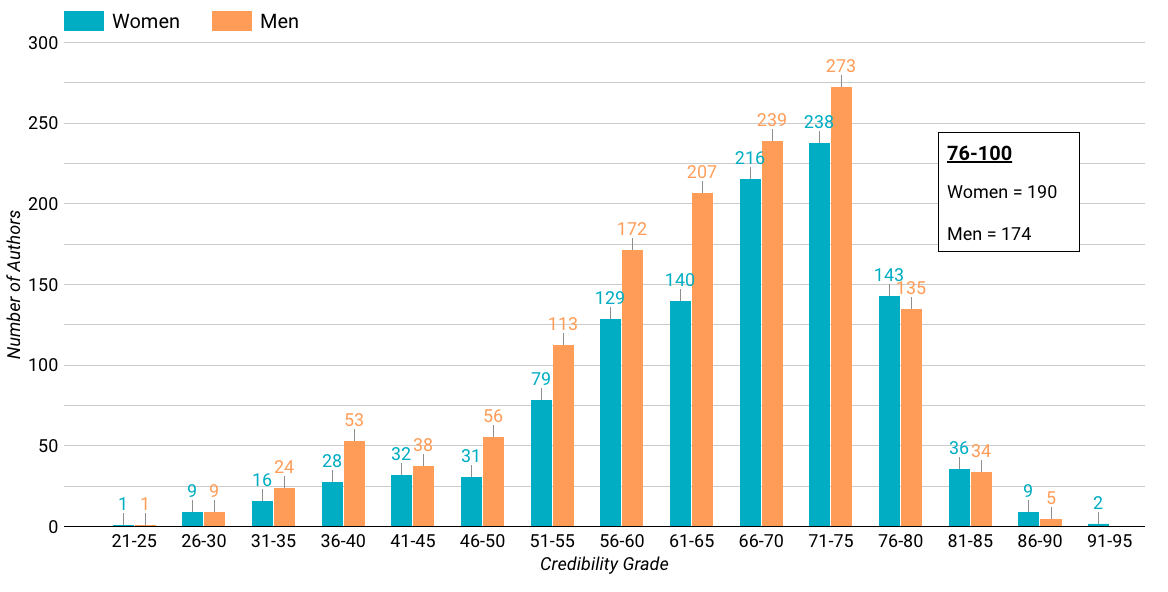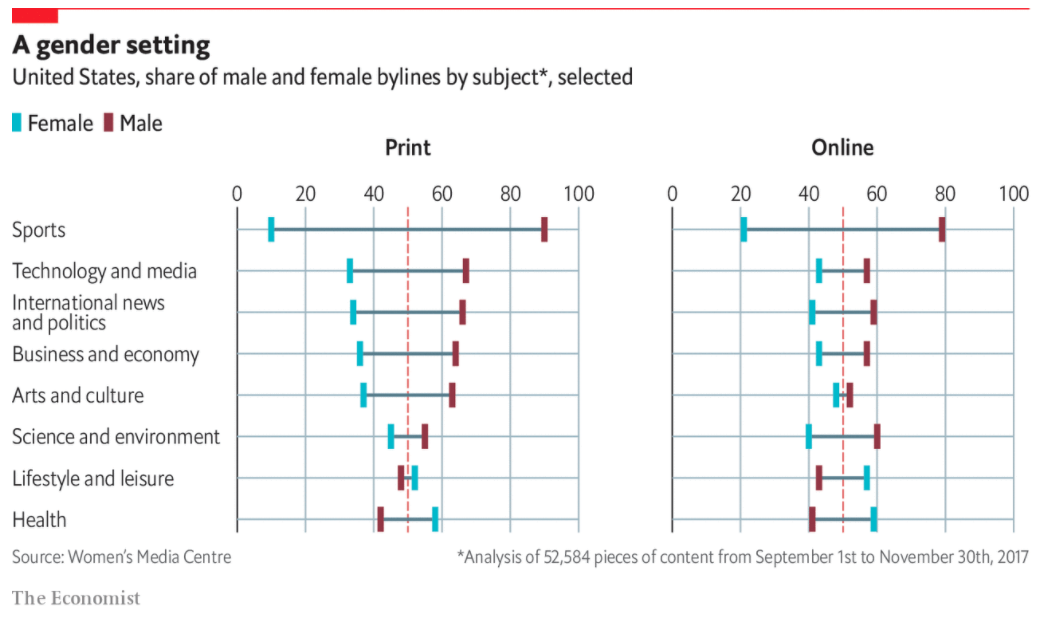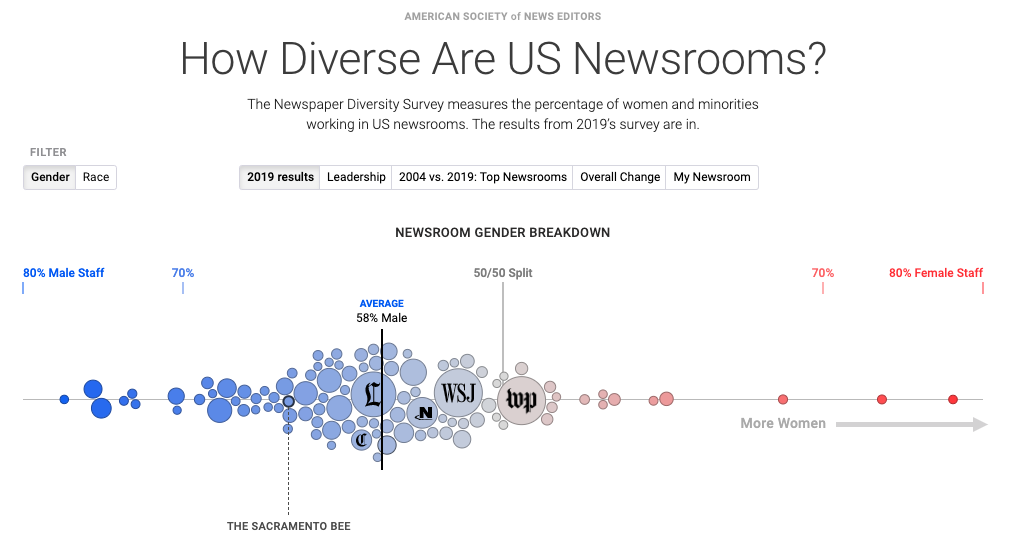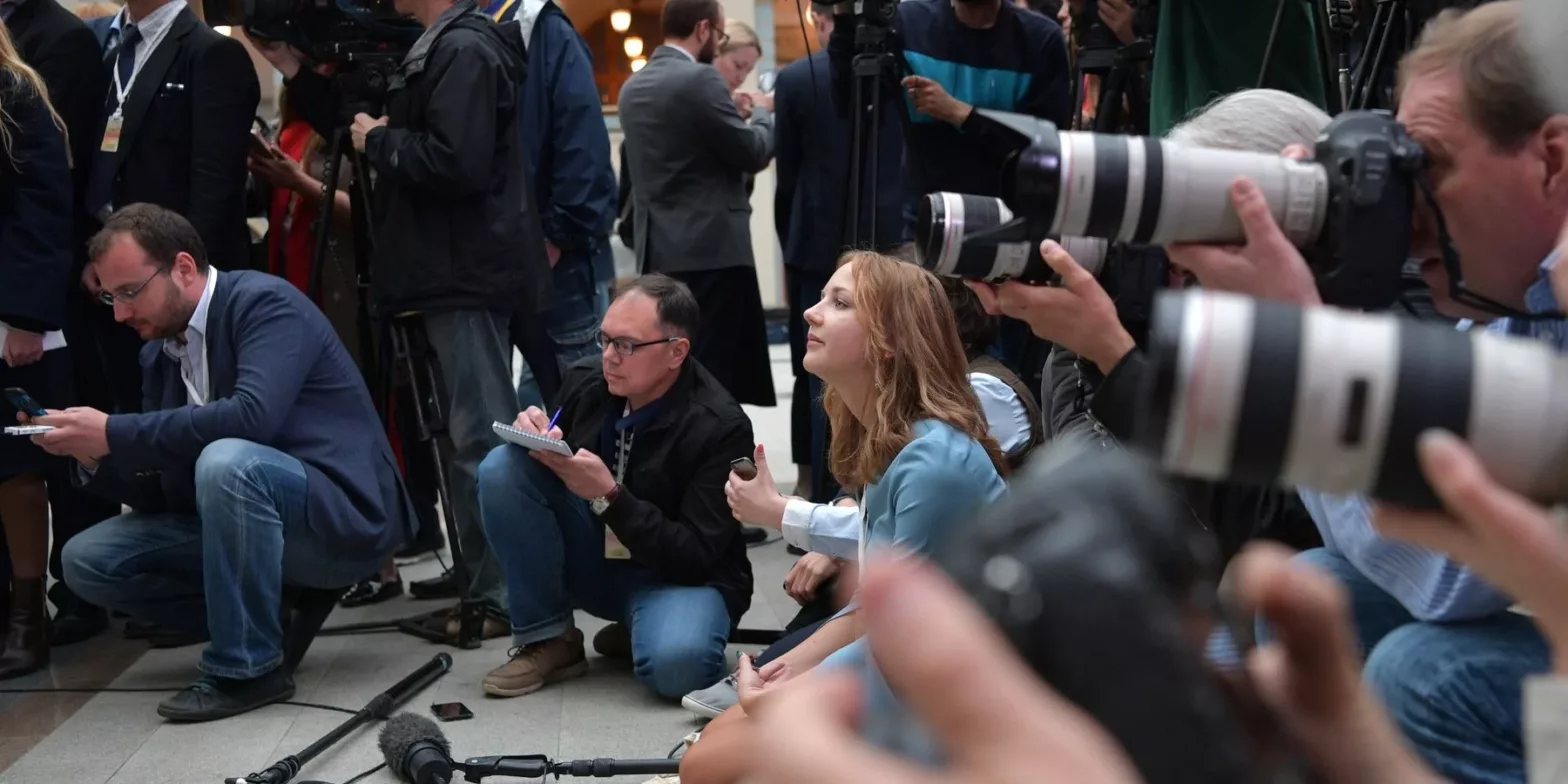By Phillip Meylan and Lucina Di Meco
On more than one occasion, The Factual has uncovered data on the U.S. media ecosystem that suggests that women journalists make up a disproportionately high number of the most credible journalists. An analysis back in April found that 8 of the top 10 journalists covering Covid-19 were women, but until today The Factual has not undertaken a systematic review to see if this is a pattern or random coincidence.
In a sample of nearly 40,000 articles about Covid-19, The Factual’s data suggests that women journalists are more credible on average than men — and that they dominate the list of the top 100 most credible journalists. When zooming out to a sample of all articles, not just those related to Covid-19, there remains a slight edge for women journalists in terms of average credibility, and they continue to be overrepresented among the most credible journalists.
The Factual’s algorithm analyzes individual articles for credibility based on the author’s topical expertise, the diversity of sources (links and quotes), the neutrality of the writing tone, and the historical reputation of the publishing site. To learn more, see How It Works.
This finding is particularly interesting given that women are underrepresented in newsrooms, reflecting a work environment where women face many challenges. In addition, women journalists are subjected to considerably more online harassment and are more likely than men to report concerns for their own well-being and safety as a result of their reporting.
In light of The Factual’s data, and at a time when getting credible news has rarely had more of a direct potential impact on our health and wellbeing, what does the under-representation of women journalists mean for the public at large?

How Much More Credible Are Women Journalists Than Men?
The Factual’s data on journalistic output reflects women’s underrepresentation in journalism. In a sample of 39,084 articles from 167 news outlets, there were 2,469 journalists who published 5 or more articles about Covid-19 from January 1 to May 14. Of these, women made up 45% of all journalists and 41% of publication output. This means men were responsible for nearly 3 in 5 stories on Covid-19 during the 135 days covered by the dataset.
When looking at the average credibility of articles from each journalist, women reporters dominate the rankings for Covid-19, accounting for 19 of the top 25 journalists and 58 of the top 100. So even as men produce nearly 60 percent of stories on Covid-19, the most credible reporting, as measured by The Factual’s credibility algorithm, comes disproportionately from women.
Please check your email for instructions to ensure that the newsletter arrives in your inbox tomorrow.
Even as men produce nearly 60 percent of stories on Covid-19, the most credible reporting comes disproportionately from women.
This trend holds over the entire sample, with men scoring an average credibility score of 63.5% (across 22,777 articles) and women scoring at 65.2% (across 16,307 articles) — a statistically significant difference. This analysis is specific to Covid-19 articles but helps illuminate the disparity between men and women journalists, with men publishing 6,470 more articles than women during these 135 days. It also suggests that women’s reporting may be some of the most in-depth and informative during this pandemic.
Top Articles from Women Journalists
“COVID-19 Face Mask Advice, Explained” – FactCheck.org – Credibility Grade: 98%
(Author: Jessica MacDonald; Author Credibility Average: 94.5%)“As COVID-19 Reshapes the World, Cultural Institutions Collect Oral Histories” – Smithsonian Magazine – Credibility Grade: 96%
(Author: Katherine J. Wu; Author Credibility Average: 85.5%)“We’re still not sure where the Wuhan coronavirus really came from” – Popular Science – Credibility Grade: 98%
(Author: Kat Eschner; Author Credibility Average: 90.4%)“COVID-19 Tests That Are Supposed To Be Free Can Ring Up Surprising Charges” – NPR – Credibility Grade: 93%
(Author: Carmen Heredia Rodriguez; Author Credibility Average: 87%)“EPA settlements are supposed to hold polluters accountable. Will coronavirus get them off the hook?” – Grist – Credibility Grade: 92%
(Author: Naveena Sadasivam; Author Credibility Average: 86.8%)
We looked to see whether this trend held true in a sample of all articles, not just those related to Covid-19, and again found that women journalists produced more credible journalism on average, though by not as wide a margin.
Over a three-week period in May, women journalists accounted for 42.0% of all reporters and 39.6% of articles but once again accounted for a disproportionately high number of the top journalists, representing 14 of the top 25, and 48 of the top 100.
For every two articles authored by women, three are authored by men. But the articles by women are, on average, more credible.
Two things are clear in The Factual’s data: (1) women journalists are underrepresented in the U.S. media ecosystem; and (2) women journalists represent many of the most credible journalistic voices. This leads to two important questions. Why do women remain underrepresented in journalism, and how might a lack of diversity be influencing the news we read?
Why Are Women Underrepresented in Journalism?
Though women represent a majority of journalism students at American universities and their overall numbers have been growing within the profession, they still face substantial barriers to advancement. The American Society of News Editors found that women make up around 41.7% of the workforce in U.S. newsrooms, but they are rarely selected for decision-making positions and are often confined to reporting on education and lifestyle.

Source: The Economist
The problem goes beyond a lack of proportional representation. According to Julie Burton, president of the Women’s Media Center, a nonprofit working to ensure women are powerfully and visibly represented in the media, women are underrepresented at critical positions: “Of particular concern is the gender gap at the wires, whose stories are picked up by news outlets across the country. Media tells us what is important and who matters, and when the wires assign 69 percent of the stories to men, the message is clear where women stand.”

Source: ASNE/Google
The challenges facing women journalists and their upward mobility still run on many different levels: from salary and promotion, to the likelihood of being considered for certain stories, to practical issues such as safety. In addition, women journalists are much more likely to experience sexual harassment in relation to their work, and in the online space, women journalists also face overwhelming threats and harassment. In 2014, Demos, a UK-based think tank, found that women journalists were 3 times more likely than men to experience abuse on Twitter.
This harassment is also heavily influenced by race. In 2017, Amnesty International surveyed millions of tweets received by 778 journalists and politicians from the United Kingdom and United States representing a variety of political views and spanning the ideological spectrum. They found 1.1 million of those tweets, 7% of the sample, to be “problematic” or “abusive” toward women. BIPOC (Black, Indigenous, People of Color) women, in particular, were 34% more likely to be mentioned in abusive or problematic tweets than white women, and black women were disproportionately targeted, being 84% more likely to be mentioned in abusive or problematic tweets than white women.

Source: IWMF Report, which surveyed 597 journalists and media workers.
The effects of such an environment are that some women journalists “avoid engaging with readers, reporting on certain topics, or say they consider leaving journalism altogether.” Moreover, they report physical and mental dangers, including “unwanted sexual advances [and] explicit voicemails threatening rape or violence.” This, too, exposes a culture of unresponsiveness, of newsrooms that lack emergency planning, and of leadership structures that downplay the challenges women face. This combination means fewer voices in newsrooms and less representative news, all with potentially detrimental effects.
Please check your email for instructions to ensure that the newsletter arrives in your inbox tomorrow.
Why Diversity in Newsrooms Matters and What Can Be Done to Achieve it
As a 2017 NPR article stated, “Without a wider range of reporters and a more layered approach to big stories, the public’s understanding is impoverished.”
Newsroom diversity has been recognized as an essential step toward ensuring a diversity of storylines and perspectives. When it comes to gender, diversity is also essential to ensuring that news does not replicate language and content that reinforces limiting gender stereotypes about men and women. For example, research from the Women’s Media Center found that women quoted women more often than men, in 42% of quotes, with men quoting women in just 27%.
These types of imbalances have knock-on effects. When it comes to political journalism, this can translate into men being more visible in the news and women in politics being considered less credible as political candidates by the electorate. Similarly, evidence from South Korea suggests that the gender of journalists directly impacts the tone of coverage of women politicians.
Women quote women more often than men, with men quoting women in just 27% of their quotes.
Solutions go beyond hiring. According to Susan Chira, editor-in-chief of the Marshall Project and formerly with the New York Times, “News media organizations need not only to be proactive about hiring women—and women of color, women from different social and educational and class backgrounds—but also much more proactive about helping them throughout their careers.” The problem, she says, is partially that “There are many women entering journalism; there are far too few in leadership positions.” The lack of women, and particularly minority women, in leadership and decision-making positions in journalism makes it harder for young women to believe that a career in this field might be possible for them, despite their academic qualifications.
As the pandemic brings to focus the gender inequality present in our society, especially in the context of race, and threatens some of the achievements women have made in the last decades, it becomes more crucial than ever to ensure that people have access to information that is credible and that includes as many perspectives as possible. Recovering from the challenges Covid-19 has posed to our health system, democratic institutions, and the economy at large will need everyone’s effort and contribution — we can’t hope to do so with so many muted voices.
Phillip Meylan is a political analyst with The Factual and a freelance writer and editor.
Lucina Di Meco is a senior expert, advocate, and writer on women’s leadership and gender equality globally. She’s the author of #ShePersisted: Women, Politics & Power in the New Media World and a director of Girls’ Education & Gender Equality at the international nonprofit Room to Read. Find her on LinkedIn and follow her on Twitter.
Want to use The Factual’s data to research trends in journalism? Reach out about collaborations by contacting Arjun Moorthy (arjun.moorthy@thefactual.com).
Appendix: Top 25 Most Credible Journalists on Covid-19
| Authors | Publisher | Average Credibility Grade | Number of Articles | |
| 1 | Jessica McDonald | FactCheck | 95% | 8 |
| 2 | Brigit Katz | Smithsonian Magazine | 92% | 5 |
| 3 | Kat Eschner | Popular Science | 90% | 5 |
| 4 | Theresa Machemer | Smithsonian Magazine | 90% | 7 |
| 5 | Julia Belluz | Vox | 88% | 29 |
| 6 | Sydney Lupkin | NPR | 88% | 8 |
| 7 | Jessica Hamzelou | New Scientist | 88% | 6 |
| 8 | Alex Fox | Smithsonian Magazine | 88% | 5 |
| 9 | Antonio Regalado | MIT Technology Review | 88% | 19 |
| 10 | Maryn McKenna | Wired Magazine | 87% | 6 |
| 11 | Pien Huang | NPR | 87% | 10 |
| 12 | Nell Greenfieldboyce | NPR | 86% | 8 |
| 13 | Katherine J. Wu | Smithsonian Magazine | 86% | 16 |
| 14 | Michael Sainato | The Guardian | 86% | 6 |
| 15 | James Temple | MIT Technology Review | 86% | 6 |
| 16 | Donald G. McNeil Jr. | New York Times | 86% | 9 |
| 17 | Megan Molteni | Wired Magazine | 85% | 17 |
| 18 | Beth Mole | Ars Technica | 85% | 25 |
| 19 | Melissa Healy | LA Times | 85% | 30 |
| 20 | Lois Parshley | Vox | 85% | 9 |
| 21 | Kristen Hare | Poynter Institute | 85% | 6 |
| 22 | Brandi Vincent | Nextgov | 85% | 6 |
| 23 | Jon Hamilton | NPR | 85% | 7 |
| 24 | Emily Pontecorvo | Grist | 84% | 9 |
| 25 | Carolyn Y. Johnson | Washington Post | 84% | 17 |

